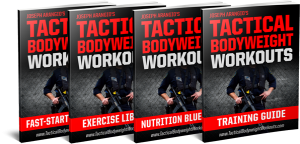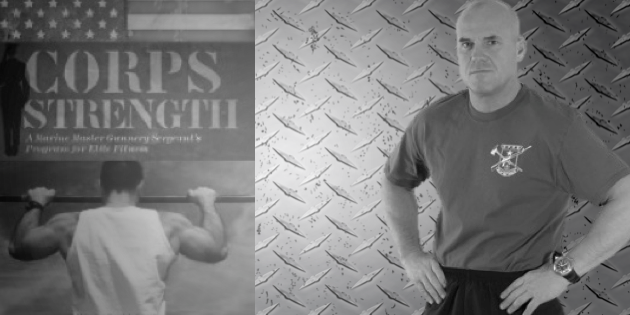Paul James Roarke Jr. is a retired United States Marine Corps Master Gunnery Sergeant. Paul joined the Marine Corps in 1981 and served on active duty for the next 28 years, during which he saw service in over 35 countries to include 3 combat tours, the last being a year in Iraq.
Since retiring from active service Paul now works as a physical training, and leadership instructor at the U.S Navy International Training Center located on the Naval Air Station in Pensacola, FL.
His fitness book Corps Strength has sold over 15,000 copies, since its release in 2010. He’s received hundreds of letters to its success in helping people lose weight and get/stay in shape.
JOSEPH ARANGIO: Provide examples of real-world bodyweight-only workouts military operators are doing in the field.
PAUL ROARKE: My own personal experience as a Marine, is that when people and/or units go forward (in the field or aboard ship), they try to stick as close to their "standard" training program as possible. Of course the confined spaces and/or lack of equipment will greatly influence what they do, but in my experience most people will do what they have found works best for them. Units will do the same, and tend to stick with the basics.
With that I feel that the most basic of bodyweight movements are the best, especially when done in combinations of push/pull, and or abs/dynamic movements (see Corps Strength for examples). The trend today, like its always been within the fitness world, is to try and find some new "wonder" exercise or food.
In fact the biggest criticism I get about my book is that my workouts aren't anything new, and many people actually seem put off that they're not complicated, or very time consuming! I go with what I know works, and most of what works isn't new, complicated or extremely time consuming.
JA: How important is it to train in your full gear, in order to prepare you for the demands of an extra 50-75 pounds of kit?
PR: This is the same as its always been, and always will be: You have to train as you fight, with all your gear. That's the same for a fireman, or SWAT cop as it is for the military. I have found that training with a quality weight vest (if done properly) can be a real benefit to obtaining/maintaining this type of conditioning.
Running while carrying a weapon (or a piece of pipe to simulate your weapon) is very important. How fast, or how far you can run in PT gear, is a completely different question than carrying gear while wearing a combat uniform and boots.
JA: Any thoughts on how to decrease incidence of landing-type injuries? Like jumping off a truck bed in full gear, landing and twisting an ankle or blowing out a knee.
PR: I think the answer to this problem may be that there is no answer. I don't care how fit you are, if you jump from the back of a seven-ton in full gear and don't land exactly right you will easily injure yourself. Good footwear helps a lot, and the boots our military have now are a thousand times better than what we had when I came in in 1981. Still this is a tough nut to crack.
My first thought is to carry less and/or lighter gear. When I was a young Marine I hated humping a heavy pack as I only weighed about 145lbs. So I learned to cut out everything I didn't absolutely need to lighten my load. Still just your "fighting load" of today: Weapon, ammo, water and protection is heavy enough around 25-30lbs at least.
JA: How important is it to train in an "adrenalized" state? In other words, getting your heart rate above 165 bpm in order to prepare for the adrenaline dump that happens when the enemy is trying to kill you.
PR: Is there really an answer for this question? I will say this; when people are scared they will be much better able to handle any situation if they're in good physical condition, are properly trained and properly LEAD. No way around those three, especially the last one. Plus in the Marine Corps we always told our people, when you're scared, tired or want to quit. Just look around you, those Marines are counting on YOU. Focus on the mission and your buddies first, they'll take care of you.
JA: What future trends do you see regarding tactical strength and conditioning?
PR: The future of all real-world conditioning is how its already been trending for several years; less bodybuilding, powerlifting and sports conditioning, and more training that mimics real-world requirements. This will be focused on overall body strength, endurance, flexibility and weight bearing (as opposed to weight lifting) movements. I talk a lot about this in my book as it's the focus of my program.
JA: List the top-10 tactical gear items every prepared citizen must own.
PR: First off I'm not a Doomsday Prepper, a Zombie hunter, or an Apocalypse fanatic. However as a retired Marine and a well-prepared citizen, especially one who lives in a hurricane zone, I always have the basics: extra food, water, weapons and some extra cash on hand.
Beyond those obvious things I think are some other important things to consider. One thing that is very important (and hardly ever mentioned) is your primary vehicle. I have a Toyota FJ (that is just short of bullet proof), and I know from experience that having reliable "all weather" transportation is a must.
Evacuating from a natural or manmade (terrorist attack) disaster is the best thing you can do for your family. You need something beyond a mini van, or sports car. I also think people need to think less tactically (like in weapons and survival gear) and more practical. Good gas cans, a quality portable generator, high quality rain/cold weather gear, a first aid kit, tarps and a (well thought out) tool kit are a must. Having 10,000 5.56 rounds and a Class IV Kevlar Vest, but no way to charge your cell phone is silly.
 Build Tactical Strength with the Ultimate Tactical Bodyweight Exercise Training Program... Over 100 Exercises. No Gym Required
Build Tactical Strength with the Ultimate Tactical Bodyweight Exercise Training Program... Over 100 Exercises. No Gym Required
Tactical Bodyweight Workouts is based on the teachings of tactical strength and conditioning coach, Joseph Arangio, MS, CSCS.
